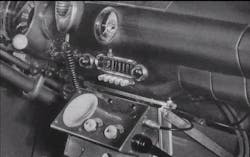DHS/FCC Warns of Interference Caused by Signal Jammers
Signal jammers are illegal and can interfere with operational channels commonly used by first responders, disrupting vital communications or affecting emergency operation. There have been documented incidents of the loss of first responder radio communications near areas where cell and GPS jammers were being used. Loss of cellular coverage was also observed in these areas which prevented 9-1-1 and other emergency calls from being made. Jammers can target cellular, GPS, Wif-Fi, and other radio signals, individually or in combination. Learn more here.
DHS's First Responder Group (FRG) Releases SAFECOM Video: Public safety communications is advancing more rapidly than ever, and helping to guide this progress is SAFECOM. This video briefly describes the SAFECOM program, an advisory group of public safety and elected officials who guide DHS in the pursuit of public safety communications interoperability. View the video here: http://go.usa.gov/M9TU.
NPSTC Files Comments on Part 22: The FCC issued a Public Notice on October 17, seeking comment on the need for more flexible Part 22 technical rules. Comments were due December 17; replies are due January 19, 2015. Some jurisdictions have used Part 22 channels to supplement Part 90 public safety channels. Public safety experience shows some flexibility is needed to do the following: Widen emission bandwidth to match allowed mask; allow mobiles and portables certified under Part 90 to operate on Part 22 channels; and modify build-out requirements to consider wide-area systems that license adjacent areas to provide interference protection.
NPSTC Files Comments on Part 90 Request: NPSTC submitted comments to the FCC regarding a request by an entity seeking to be a Part 90 frequency coordinator. In its Public Notice, the Commission seeks comments on a request by Engineers Frequency Advisory Committee, LLC (EFAC) to be certified as a frequency coordinator in the Part 90 radio services. EFAC is the latest of three companies that have requested Commission certification as a Part 90 frequency coordinator.
In NPSTC's view, none of these three companies meet the Commission's qualifications to be certified as a Part 90 frequency coordinator. NPSTC believes it is essential that public safety and industrial/business users be served by frequency coordinators that represent the respective user bases for which they coordinate, provide coordination in a fair and equitable manner, possess the requisite technical skills and coordination experience and understand the many nuances of the Commission's Part 90 rules.
The current Part 90 frequency coordination environment works well. Current coordinators are representative of the base of users for which they coordinate frequencies, provide service in a fair and equitable manner and already provide a competitive frequency coordinator marketplace. In NPSTC's view, the Commission is fortunate to have the current group of dedicated certified frequency coordinator organizations. NPSTC opposes experimenting with this proven situation, as doing so could be detrimental to public safety.
NPSTC is a federation of organizations whose mission is to improve public safety communications and interoperability through collaborative leadership.
Support provided by the U.S. Department of Homeland Security's Science and Technology Directorate, Office for Interoperability and Compatibility, and the National Program and Protection Directorate, Office of Emergency Communications. Points of view or opinions expressed are those of the originators and do not necessarily represent the official position or policies of the U.S. Department of Homeland Security.






